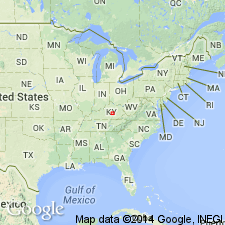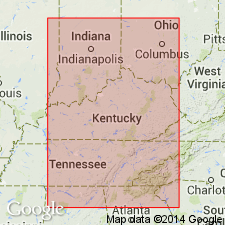
- Usage in publication:
-
- Preachersville Member*
- Modifications:
-
- Named
- Dominant lithology:
-
- Mudstone
- Dolomite
- AAPG geologic province:
-
- Cincinnati arch
Summary:
Named Preachersville Member of Drakes Formation, upper member of two. Chiefly composed of grayish-green dolomitic or limy, sparsely glauconitic silty mudstone which is obscurely bedded in fresh roadcuts but weathers readily to platy fragments a fraction of an inch thick and a few inches across. Many bedding surfaces are covered by ripple marks or mud cracks. Megafossils are absent or very sparse. Also contains 10 to 20 percent argillaceous, fine-grained dolomite in resistant beds, a few inches to a few feet thick; commonly the thicker beds are near the base of the member. Some dolomitic beds contain abundant poorly preserved bryozoans and sparse brachiopods. In places, the base of the member is marked by as much as 6 feet of fossiliferous limestone containing abundant colonial corals and stromatoporoids. The Preachersville member ranges from 55 to 95 feet in thickness. Underlain by Rowland Member; overlain by Brassfield Dolomite of Early Silurian age.
Source: GNU records (USGS DDS-6; Reston GNULEX).

- Usage in publication:
-
- Preachersville Member*
- Modifications:
-
- Overview
- AAPG geologic province:
-
- Cincinnati arch
Summary:
The Preachersville Member of the Drakes Formation in south-central KY consists of grayish-green dolomitic or calcareous silty mudstone and finely crystalline dolomite or dolomitic limestone. The basal part contains colonial corals and stromatoporoids. Thickness is 55 to 95 feet. Overlies the Rowland Member of the Drakes Formation on the southern and eastern sides of the Lexington dome. The Preachersville is of Late Ordovician (Richmondian) age.
Source: GNU records (USGS DDS-6; Reston GNULEX).

- Usage in publication:
-
- Preachersville Member*
- Modifications:
-
- Age modified
- AAPG geologic province:
-
- Cincinnati arch
Summary:
Age of Preachersville Member of Drakes Formation is refined to Cincinnatian (Richmondian).
Source: GNU records (USGS DDS-6; Reston GNULEX).
For more information, please contact Nancy Stamm, Geologic Names Committee Secretary.
Asterisk (*) indicates published by U.S. Geological Survey authors.
"No current usage" (†) implies that a name has been abandoned or has fallen into disuse. Former usage and, if known, replacement name given in parentheses ( ).
Slash (/) indicates name conflicts with nomenclatural guidelines (CSN, 1933; ACSN, 1961, 1970; NACSN, 1983, 2005, 2021). May be explained within brackets ([ ]).

